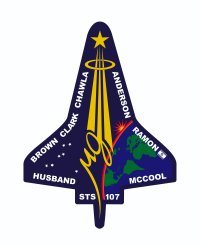Thu, Jan 30, 2003
STS-107 Report #14; Tuesday, January 28, 2003 -- 5 p.m.
CST
 The Red team of astronauts aboard the Space
Shuttle Columbia accomplished repairs on the third and
final combustion experiment of STS-107 this afternoon, and support
scientists on the ground were looking forward to working with the
Blue team on the first scientific runs.
The Red team of astronauts aboard the Space
Shuttle Columbia accomplished repairs on the third and
final combustion experiment of STS-107 this afternoon, and support
scientists on the ground were looking forward to working with the
Blue team on the first scientific runs.
Mission Specialist Kalpana Chawla reported a good leak check of
the Combustion Module-2 Facility about 4 p.m. after five hours of
work. She and Commander Rick Husband sent down video of the
recovery procedures for the Water Mist Fire Suppression Experiment
(MIST) around 2 p.m. to give engineers on the ground an opportunity
to visually inspect the equipment. The combustion facility, which
provides control, containment, diagnostics and communications for
fire-related experiments, worked flawlessly in support of the two
previous combustion experiments, but failed its initial leak checks
when MIST was installed Monday.
Payload Commander Michael Anderson of the Blue team is scheduled
to begin work with the MIST experiment overnight. Designed by
the Center for Commercial Applications of Combustion in Space at
the Colorado School of Mines, Golden, Colo., the experiment will
investigate how water mist inhibits the spread of flames.
Scientists hope to apply what they learn to designs for improved,
lighter-weight fire suppression systems on Earth, as well as for
spacecraft-based systems that won’t require ozone-damaging
chemicals such as Halons.
 Husband, Chawla and Red team colleagues Lauren
Clark and Ilan Ramon enjoyed some time off for the first half of
their day, then moved ahead with other experiments in the Spacehab
Research Double Module. Clark retrieved samples associated with the
Bioreactor Demonstration System, which Project Scientist Tom
Goodwin reported today has grown a bone and prostate cancer tumor
tissue sample as large as a golf ball, the largest grown in space
to date. She also collected blood and urine samples from her
crewmates for the Physiology and Biochemistry (PhAB4) suite of
experiments. Ramon also conducted observations of dust off the
African coast for the Mediterranean Israeli Dust Experiment
(MEIDEX).
Husband, Chawla and Red team colleagues Lauren
Clark and Ilan Ramon enjoyed some time off for the first half of
their day, then moved ahead with other experiments in the Spacehab
Research Double Module. Clark retrieved samples associated with the
Bioreactor Demonstration System, which Project Scientist Tom
Goodwin reported today has grown a bone and prostate cancer tumor
tissue sample as large as a golf ball, the largest grown in space
to date. She also collected blood and urine samples from her
crewmates for the Physiology and Biochemistry (PhAB4) suite of
experiments. Ramon also conducted observations of dust off the
African coast for the Mediterranean Israeli Dust Experiment
(MEIDEX).
More News
Aero Linx: JAARS Nearly 1.5 billion people, using more than 5,500 languages, do not have a full Bible in their first language. Many of these people live in the most remote parts of>[...]
'Airplane Bounced Twice On The Grass Runway, Resulting In The Nose Wheel Separating From The Airplane...' Analysis: The pilot reported, “upon touchdown, the plane jumped back>[...]
"Burt is best known to the public for his historic designs of SpaceShipOne, Voyager, and GlobalFlyer, but for EAA members and aviation aficionados, his unique concepts began more t>[...]
"Polaris Dawn, the first of the program’s three human spaceflight missions, is targeted to launch to orbit no earlier than summer 2024. During the five-day mission, the crew >[...]
There Are SO Many Ways To Get YOUR Aero-News! It’s been a while since we have reminded everyone about all the ways we offer your daily dose of aviation news on-the-go...so he>[...]
 ANN's Daily Aero-Linx (05.04.24)
ANN's Daily Aero-Linx (05.04.24) NTSB Final Report: Quest Aircraft Co Inc Kodiak 100
NTSB Final Report: Quest Aircraft Co Inc Kodiak 100 Aero-News: Quote of the Day (05.04.24)
Aero-News: Quote of the Day (05.04.24) Aero-News: Quote of the Day (05.05.24)
Aero-News: Quote of the Day (05.05.24) Read/Watch/Listen... ANN Does It All
Read/Watch/Listen... ANN Does It All




